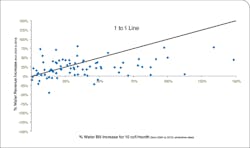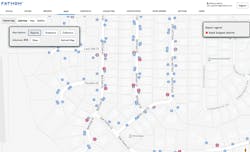Throughout 2010 to 2015, water availability in Texas was plummeting. Learning from California—where a continued drought resulted in mandatory action for water providers—Texan regional water authorities began to implement drought contingency plans, the impact of which would have far reaching consequences for the financial sustainability of water utilities.
In the Tarrant Regional Water District (TRWD), Stage 1 Drought Measures were implemented which included limiting outdoor watering with hose-end sprinklers and automatic irrigation systems to no more than twice per week, and only at certain times of the day.
For Kennedale, TX, a community of more than 7,000 people in the Dallas-Fort Worth area that obtains half of its water supply from TRWD, the drought measures sparked a drive for resource sustainability. However, while the need for these restrictions was clear, the immediate revenue impacts were also threatening the City’s ability to invest in ensuring that their aging infrastructure continued to provide safe and efficient water for their residents.
As in most cases when utilities are faced with revenue shortfalls, Kennedale sought to increase the rates charged for water. In this case, however, the City’s leadership also understood that rate increases were not a long-term solution: the murky message instantly puts the utility at odds with its customers (“using less water is good, but will cost you more”), while simply resulting in further conservation and revenue destruction.
Finding a solution to reduced water deliveries meant looking across the entire meter-to-customer vertical to maximize efficiency.
THE RATES-TO-REVENUE FALLACY
On average, a 10% increase in the marginal cost of water can be expected to reduce residential demand by 3 to 4% in the near term as customers clamp down on their discretionary water use. As customers adopt structural changes to their water use, such as turf grass removal, fixture retrofits, etc., the impact of a 10% rate hike can be expected to yield a 6% decrease in demand (Olmstead and Stavins 2008).
However, simply increasing rates to make up for this 3 to 6% reduction in consumption is not a guaranteed success. Because water prices have been increasing steadily for many years, in many cases the cost of water is now a noticeable element of a customer’s monthly budget. As a result, the costs of water are entering the “zone of elasticity”—the point at which further increases result in decreased consumption.
For water utilities, this means that there is no longer a one-to-one relationship for rate-to-revenue increases. In fact, analyses by the University of North Carolina Environmental Finance Center have demonstrated that utilities are seeing less return from rate increases as customers adapt to their new costs with increasing demand destruction.
THE CITY’S SOLUTION
Recognizing this, Kennedale was keen to develop a program whereby both customers and the utility could achieve ever increasing efficiency. For the customer, that meant using data and engagement tools to reduce consumption and encourage conservation; for the utility, the focus was on revenue assurance and cost reduction. Together, customers and the utility could conjure the alchemy of conservation and revenue protection and meet the resource and revenue stability necessary in the increasingly volatile water environment.
To accomplish this, the City selected FATHOM to upgrade their metering systems through the adoption of Advanced Metering Infrastructure (AMI), apply FATHOM’s data-driven analytics and meter data management (MDM) platform, modernize their Customer Information System (CIS) with FATHOM CIS, and enhance their customer engagement through FATHOM’s U2You customer portal.
This bundled approach to improving the data and processes around billing and customer service allowed Kennedale to reduce the costs of managing the meter-to-customer processes, while using FATHOM’s Revenue Assurance mechanisms to ensure all available revenue was collected. Further, by combining this platform with FATHOM’s
U2You customer engagement platform, the City offered its customers the ability to actively engage in their water use, using near-real-time information and notifications.
TAKING THE BITE OUT OF CONSERVATION
FATHOM’s Revenue Assurance program provides geospatial and cross-platform analyses to identify “leaking revenue” from a water utility. FATHOM has proven that due to the nature of many water utilities, over time, it is very common for the physical infrastructure (those assets in the ground) to diverge from the logical infrastructure (those assets in the utility’s data systems). Maintaining the alignment of infrastructure and data systems has always been a manual process—field checking infrastructure and manually updating and repairing data faults. And because these audits are performed only intermittently, the field results themselves get stale very quickly, exacerbating the divergence of information. Further, as metering and customer information systems are some of the longest-lived assets in a utility, this decoupling of assets and data can mean significant lost revenue.
By applying mobile-enabled data collection devices, and combining data layers and elements from other sources such as parcel taxation data, building department records, GIS-centric customer information systems, highly granular AMI systems, etc., it is possible to maintain the alignment of the physical and logical assets, creating a continuously electronically validated meter population, and maximizing revenue assurance.
Working on the water sales, or meter side of the ledger, also increases the utility benefits. In the rush to efficiency, many utilities immediately adopt a non-revenue water (NRW) reduction program focused on distribution system leak detection and repair. There are two fundamental flaws to this approach: first, as much as two-thirds of the water reported as non-revenue water are apparent losses, not real losses; and second, the cost to a utility of a physical leak in the distribution system is the marginal cost of water production, whereas the cost of water lost through meter inaccuracy or other billing system data error is the price of water to the customer. At higher consumption levels, the difference between these can be 20 to 30 times.
ENGAGING THE CUSTOMER
In concert with pricing mechanisms to encourage demand-side conservation, there is a growing understanding that people, when properly informed, can and do make conscious decisions about their water use (Schwabe et al. 2014).
With found revenue stabilizing and providing a counterweight to conservation, the utility can then focus on ensuring that their customer usage is as efficient as possible. This has the dual advantage of reducing the costs of delivery while reducing the costs for each customer.
A fundamental element in the success of these programs, however, is that the messages need to be timely, meaningful, and accurate. It is of little use for a customer to be told of excessive use one, two, or 12 months after the fact. Utilities need to adopt a proactive communication medium with their customers: informing them of potential leaks, excessive usage, high cost, and a multitude of other events. This demands granular, high frequency water use data.
SEIZING OPPORTUNITY
The City of Kennedale embraced the water crisis in Texas to fundamentally change their approach to water sustainability. The City combined FATHOM MDM, AMI, FATHOM CIS, and FATHOM U2You to focus on fixing the data first to ensure the maximum collectability of revenue from their existing infrastructure while being able to encourage conservation. This data-driven, demand-side management approach improved utility revenue by 5.8% by charging for all the water delivered, while actually selling less water (per capita demand was reduced by 17.5%). And in doing so, the City reduced non-revenue water from 13.3 to 6.6%.
Overall, the ability to meet conservation objectives, reduce costs, and improve revenue has put Kennedale on a clear path to sustainability—one that is now prepared for current and future water volatility in Texas.
REFERENCES
Olmstead, S., and R. Stavins, “Comparing price and nonprice approaches to urban water conservation”, Water Resources Research, 45, W04301, 2008.




